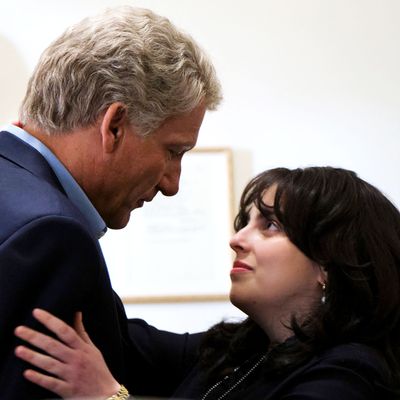
The new FX limited series Impeachment: American Crime Story — the third in a true-crime anthology that started with The People v. O.J. Simpson and continued with The Assassination of Gianni Versace — covers the events leading up to Bill Clinton’s impeachment in December 1998, with a heavy emphasis on the fallout from his sexual relationship with Monica Lewinsky. Fans of the brilliant Slate podcast Slow Burn will surely remember many details from its Leon Neyfakh–hosted second season three years ago, which included among its eight episodes bonus interviews with major players like Ken Starr, the special prosecutor and author of the infamous Starr Report, and Linda Tripp, who had befriended Lewinsky at the Pentagon and helped reveal her secret affair to the independent counsel’s office.
For all ten episodes of Impeachment, we’ve asked Madeline Kaplan, the researcher for the Clinton-Lewinsky season of Slow Burn, to fact-check the show’s major events and minute details against her own understanding of the events. (Kaplan and Neyfakh’s eight-book reading list can be found here and doesn’t include the Starr Report and its eyebrow-raising appendices.) Kaplan followed Neyfakh (and co-creator Andrew Parsons) to Prologue Projects, where she serves as a producer on Neyfakh’s Fiasco and other podcasts.
In the second episode, “The President Kissed Me,” the show flashes back to Lewinsky’s first intimate encounters with President Clinton during the 1995 government shutdown, when her internship landed her a job at the desk of Chief of Staff Leon Panetta. It also reveals the disappointing aftermath of Clinton’s re-election in 1996, when Lewinsky, devastated over a broken promise to return to the West Wing, divulges Clinton’s name to Tripp for the first time, confirming Tripp’s suspicions. Meanwhile, the Paula Jones civil lawsuit draws interest from right-wing opportunists, particularly Susan Carpenter-McMillan (Judith Light), who offers to help Jones reinvent her public image in a bid to pursue her own political goals.
Kaplan talked about the beginning and end of Lewinsky and Clinton’s romantic relationship, Jones’s personal and political makeover, and the thoughtful gifts exchanged between intern and president.
The Big Stuff
The major plot and character beats that shape Impeachment’s narrative.
Would the affair have even been possible without the government shutdown?
“Probably not. They have far fewer people working in the West Wing [because of the shutdown], so there’s a lot more opportunity to be alone. Also, while [Lewinsky] had her internship, she had gotten a full-time job [as a staff assistant for correspondence in the Office of Legislative Affairs, in the East Wing of the White House], but it hadn’t started yet. The fact that she was assigned to then–Chief of Staff Leon Panetta, to his office, put her in pretty close proximity. So it definitely makes sense.”
Flirtations before Lewinsky and Clinton’s first intimate encounter
“She described in her testimony multiple instances where they were sort of making eye contact or that she definitely felt some kind of flirtation there, that there was something unusual happening around this time before they met in person.”
Their first private encounter
“The way the episode is structured, I think the timeline of their relationship is kind of deliberately obscured. The escalation of their relationship happened relatively quickly. So actually that moment where they have their first kiss and the moment when she exposes her underwear happened on the same day [in real life]. A lot of it’s pretty accurate, like when they were both alone in George Stephanopoulos’s office — that’s where they have that first conversation where she tells him she has a crush on him and they kiss for the first time. The intern-badge moment where he tugs on her intern pass and says, “This might be a problem,” is the kind of thing that feels like it might have been invented for TV, but that was real, although he technically said that during another encounter they had later that night. Then a few days later, she brought the pizza to his office at his suggestion.”
Lewinsky’s relationship with the friend who knows about this affair before Tripp
“She calls her Cat, so that’s probably Catherine Allday Davis. That’s one of her friends from college who she did see. I’m not sure that she actually saw her in person right then because at some point Catherine moved to Japan for a little while with her husband, but they definitely kept in touch. And she is one of the 11 people [Lewinsky] told. Since she was living in Japan keeping in touch with Lewinsky from afar, a lot of what prosecutors wanted were their emails back and forth about this. And eventually, they ended up flying her in from Japan to testify before the grand jury.”
Secretary Betty Currie’s role as liaison in this relationship
“In large part, the show gets it right. Monica would call her to try to arrange meetings. Sometimes, she would call Monica to say, ‘The President would like to meet with you.’ Sometimes, she would be like the go-between for gifts, that kind of thing.”
The gift exchanges
“All these gifts they show are all accurately things they gave each other. Some of the timing’s a little bit off, like the specific order in which she gave him gifts grouped together is not right. There’s this really crazy chart that’s in one of the appendices of the Starr Report (viewable here, starting on page 116) that clearly lays out all their contacts with one another, and there’s a column for gifts given. So all these gifts appear there. Like the Oy Vey Jewish humor book is real and the frog thing she gives him. He gives her Leaves of Grass.”
Lewinsky’s ’96 election looks
“I don’t know if it was on Election Day itself, but she did say she got a haircut and picked out what she was going to wear. She went to that victory celebration the next day and then I think she was thinking that [Clinton] was going to call to try to see her that coming weekend.”
Tripp’s reaction to Lewinsky revealing her secret lover’s identity
“This is one of the major discrepancies between the accounts of these two women. Lewinsky, after the fact, said that [Tripp] was very eager for information, very excited by this, and very encouraging in general. Whereas Linda said that she was pretty disgusted that the president would do something like this. That she was horrified for Monica, upset for her on her behalf. And so that if she was concerned, it was out of that frustration and disgust, rather than just trying to get information. The show, it seems to me, is going more towards Monica’s interpretation, which makes sense.”
Lewinsky’s move from the White House to the Pentagon
“I don’t know that [Clinton] saw this as a liability and had to get her out because he cared about her so much, but some people around him did. Her proximity, her age, and all the things that end up becoming really complicated about this, making it into a big scandal … the people around him, certain people, definitely noticed. Basically, Lewinsky’s transfer was the brainchild of Deputy Chief of Staff Evelyn Lieberman, who felt like Lewinsky was spending too much time hanging around the West Wing trying to get close to the president. And whether or not she knew there was anything actually going on between them, Lieberman felt like her presence was a distraction and could lead to the kinds of rumors that perennially followed Clinton.”
Tripp’s position on Michael Isikoff’s Newsweek story on Kathleen Willey
“When Isikoff approached her about this, he basically said, ‘Kathleen Willey told me that you would corroborate her story.’ And then she says, ‘I corroborate that it happened, but it was not sexual harassment. She was very excited.’ Tripp described most recently in her memoir that she later came to believe that she misinterpreted things. I think she would say that she earnestly misinterpreted and that she did not feel that she was being at all dishonest [about Willey] but that she was accurately representing what she remembered. I guess it’s the show’s freedom to imply what it wants to imply there.”
The Excel spreadsheet of events
“This is described in the Starr Report and various places as happening, and at her grand-jury testimony, Monica talks about this. She describes an exchange where Linda’s like, ‘I’m good at seeing patterns. Let’s see if there’s a pattern here,’ although I don’t think they were necessarily on her personal computer. The way that it’s described in the report, Monica made an Excel spreadsheet at her DOD computer and didn’t save it but printed it out so that they could go over it or look at it or talk about it.”
Susan Carpenter-McMillan’s role in the Paula Jones lawsuit
“In ’97, she announces that she is Paula Jones’s spokeswoman. There’s a lot of tension between her and Jones’s lawyers during a lot of this time, which we’ll see in the next episode. She gets connected to Jones somewhat randomly and then really kind of adopts her, in a way, or decides to take on her cause. I think this is a fairly accurate representation in terms of a very media-savvy, very strategic approach to Paula. There are certain things they skip over in this, understandably, about book deals, about trying to sell this sealed affidavit about the ‘distinguishing characteristics.’ But yes, she’s very involved. A lot of the stuff about the makeover, that’s all her. There are articles about how she took Paula to Nordstrom, which they show, and Macy’s. She got her hairstylists. Paula did have braces, very famously, during this period.”
The parallels between Tripp’s relationship with Lewinsky and Carpenter-McMillan’s relationship with Jones
“That was interesting because I do think [they were parallel] in a lot of the ways that Tripp has described their relationship — or did describe it in the years afterwards — as her having a lot of maternal feelings towards Monica and that she felt like she was protecting her and doing this for her own good. And while all the Paula Jones stuff was happening, Susan Carpenter-McMillan often referred to her as like a kid sister. So I think they both, in some sense, cultivated, whether unknowingly or knowingly, that type of relationship.”
Odds and Ends
The details and embellishments that may or may not be rooted in the historical record but reflect Impeachment’s stylistic approach.
On interesting gifts that didn’t make the cut
“At some point, I don’t remember exactly when, Clinton hurts his knee or is somehow injured. And [Lewinsky] put together a whole gift basket of things for his injury. She got him a little vanity license plate for a wheelchair if he had to be wheeled around, and she got him some kind of kneepad or something with the White House or presidential seal on it. I thought that was pretty interesting, just because there’s a level of real thought and care to it.”
On Clinton’s Diet Coke thing
“[Lewinsky] said later that was part of their cover. If she were to walk out of his office or walk out of a meeting with him with a Diet Coke, it would seem less suspicious because what could you possibly have been doing if you’re just walking out casually with a Diet Coke? Also, apparently he really liked Diet Coke.”
On Tripp’s passion for antiquing
“Tripp ended up living on a horse farm and running a Christmas store with her husband after this, which they telegraph very clearly in the episode when she sees that little Christmas scene and mentions it.”


